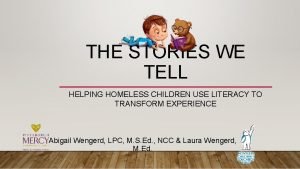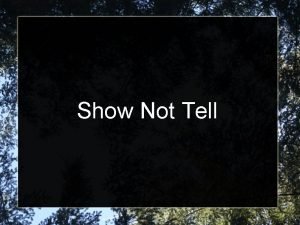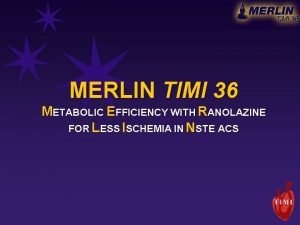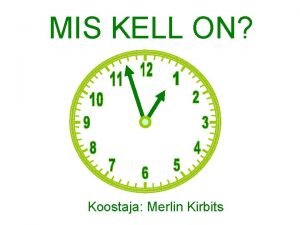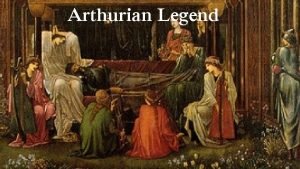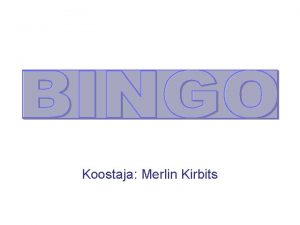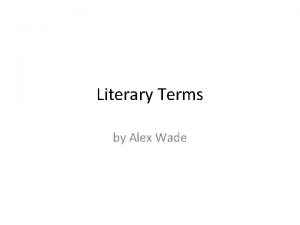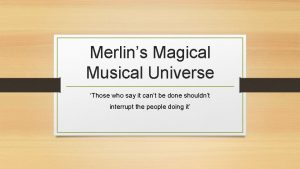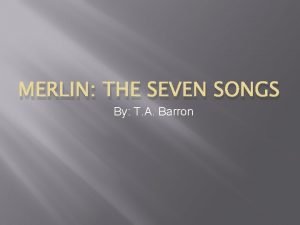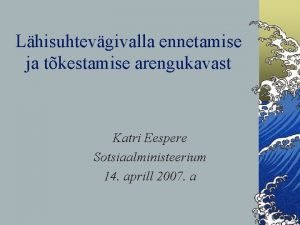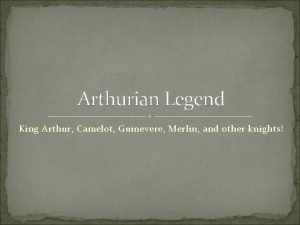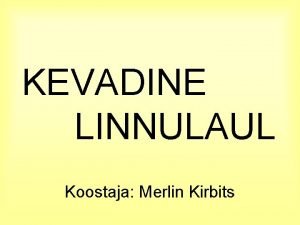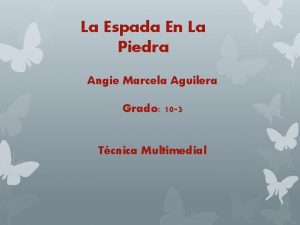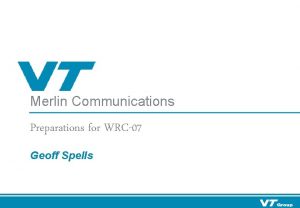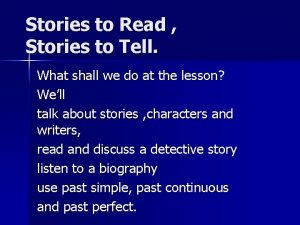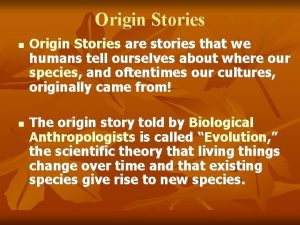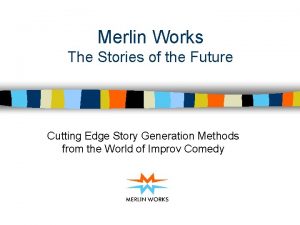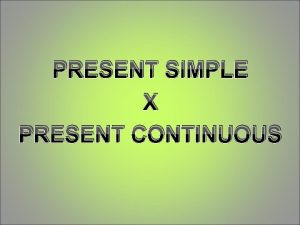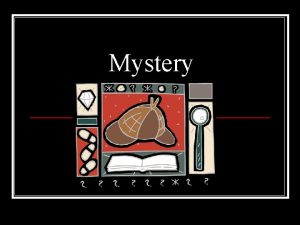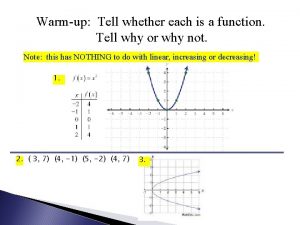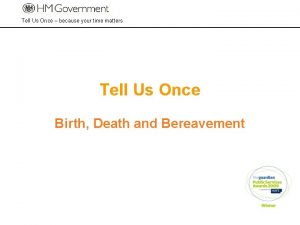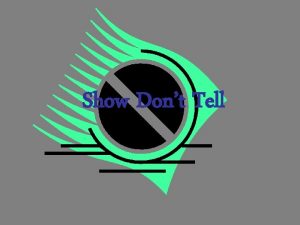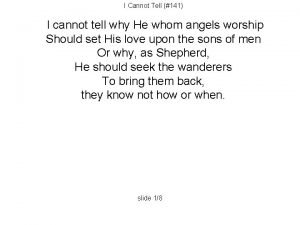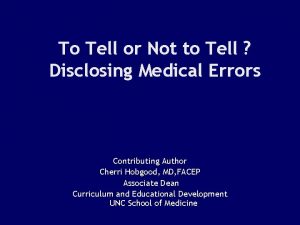How to tell stories Merlin Goldman Stories usually























- Slides: 23

How to tell stories Merlin Goldman

Stories usually have a § Beginning § Middle What is a story? § End § Some characters

The Shapes of Stories Kurt Vonnegut § https: //youtu. be/o. P 3 c 1 h 8 v 2 ZQ § 7 Shapes: https: //youtu. be/CYCb. Pso. Wo 2 k

A character exists in a place and something about it causes him to suffer. They realises they have to do something so they go on a journey which may or may not be physical. Recurring motif On their journey they confront obstacles which they may or may not overcome. They either learn something about themselves (= tragedy) or don’t (= comedy). Therefore there are 8 different endings.

Character gets what they want? Character gets what they need? Character learns something? Yes Yes Yes No *Yes No No No Yes No No Yes * Luke Skywalker wants adventure. He needs companionship. He realises the value of friendship.

WANT § Something you’d like to have e. g. bigger TV § All characters usually want something over and above their basic needs Wants vs. Needs NEED § Something you have to have e. g. food § Sometime the need can be so overwhelming it can drive the story e. g. survival

1. Idea. Something that bothers you. 2. Explore it. Let your subconscious work on it. 3. Perform research How do I write? 4. Find a focus e. g. central character 5. Select the best stuff 6. Recognise an order 7. Write a quick draft 8. Edit

§ There aren’t any § But there are things you can do that should make your § Plot more dramatic What are the rules? § Your characters more rounded § The story more fulfilling Whether you follow these guidelines is up to you!

Poetics Aristotle

"The real rules can be found in Aristotle's Poetics. " Aaron Sorkin § There are comedies, epics but tragedy is superior § It should mimic real life Structure § We see representations of people worse, the same or better § It should have a beginning, middle and an end § You can have a plot without characterisation e. g. James Bond

§ You can do anything to your characters but it should seem proportionate, however fantastical § Scenes can be simple or complex Poetics: Structure § Simple: a scene naturally follows the last one § Complex: a scene involves new knowledge or an unexpected turn § Complex scenes can include § 1. Full knowledge § 2. Partial knowledge e. g. attack wrong person § 3. Partial knowledge to full knowledge

§ You don’t need to focus on a single character but if you do all their actions should be relevant to the plot § The main characters should undergo a transformation § Actions show character Poetics: Characterisation § Characters should have some of these qualities 1. 2. 3. 4. Good Believable Likeable Consistent § Symbols and objects can be powerful tools

Modern

Ten Questions John Yorke 1. Whose story is this? 2. What do they want/need? 3. What is the inciting incident? 4. What does the protagonist want specifically? 5. What obstacles are in the way? 6. What’s at stake? 7. Why should we care? 8. What does the protagonist learn? 9. How and why do they learn this? 10. How does the story end?

Excercise

§ Profession § something you know or is familiar Protagonist § Place § somewhere you know or we all know § Problem § wants something but can’t get it

§ The opponent to your hero § He wants the same thing but for different reasons Antagonist § Or what he wants is at odds with what the protagonist wants § He doesn’t have to be a he or a human e. g. Jaws. Can occasionally be multiple.

1. What do they love the most? 2. What is their flaw? Characterisation 3. What is their conflict? 4. How does it get worse? 5. What bad decisions do they make?

§ The clearest stories have two people who want the same thing but they both can’t have it. Summary § The cat sat on the mat § The cat sat on the dog’s mat § Exceptions?

Beat An event, decision, or discovery that alters the way the protagonist pursues his or her goal.

Theme Stated Act One (thesis) 10 Cards Set-up Phases Beat Required Opening Image Page 1 2 Save the cat 3 4 Theme Stated 5 6 7 Debate Break into two Inciting Incident 8 9 10 11 12 13 14 15 16 17 18 19 20 21 22 23 24 25 Save the cat Scene Description Opening Beat Location Image Break into two Save the cat Inciting Incident Act. Two (antithesis) 10 Cards B story Phases Time Adventure Midpoint (False peak or collapse) Beat Required Page 26 27 28 29 30 31 32 33 34 35 36 37 38 39 40 41 42 43 44 45 46 47 48 49 50 51 52 53 54 82 83 84 Scene Description Beat Location Act. Two (antithesis) 10 Cards Phases Bad Guys Close In Dark Night of the Soul Beat Required Page All is lost (False defeat) 56 57 58 59 60 61 62 63 64 65 66 67 68 69 70 71 72 73 74 75 76 77 Death 78 79 80 81 Scene Description Beat Location Act Three (synthesis) 10 Cards Finale Phases Beat Required Page Scene Description Beat Location Final Image Break into three 85 86 87 88 89 90 91 92 93 94 95 96 97 98 99 100 101 102 103 104 105 106 107 108 109 110 55

Sequences 1. Establishment Scenes 2. Problem 3. Possible Solution 4. Action 5. Crisis 6. Resolution

§ Stories have different story arcs but usually revolve around one person seeking a solution but being prevented by something or someone else § Characters should have familiar traits § We show who they are through what they do Conclusion § Plots with more complexity have greater impact § This can be achieved through action, reversals and surprises § We can use sequences and beats to help us write scenes and structure our story
 Ppt on walls tell stories
Ppt on walls tell stories The stories we tell ourselves
The stories we tell ourselves Tell me what you eat and i shall tell you what you are
Tell me what you eat and i shall tell you what you are Show not tell technique
Show not tell technique Piq
Piq Merlin timi 36
Merlin timi 36 Merlin kirbits
Merlin kirbits Merlin malt
Merlin malt Kirbits
Kirbits Merlin sepp
Merlin sepp Merlin tatrik
Merlin tatrik Stichomythia
Stichomythia Unin merlin
Unin merlin Seven songs of merlin
Seven songs of merlin Katri eespere
Katri eespere Fornecedor leroy merlin
Fornecedor leroy merlin Merlin kb
Merlin kb King arthur prophecy
King arthur prophecy Kevadine linnulaul
Kevadine linnulaul Alton towers values
Alton towers values Merlin communications
Merlin communications Merlin google drive
Merlin google drive Merlin tatrik
Merlin tatrik Merlin pelicula animada
Merlin pelicula animada

